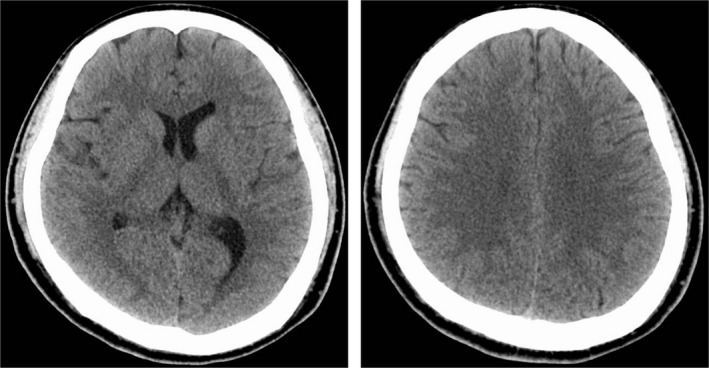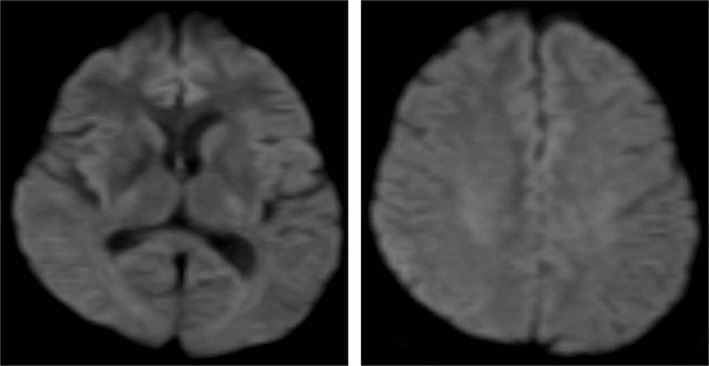Abstract
Background
Nowadays, it is getting easier to search information about helium‐assisted suicide online. Therefore, healthcare professionals must understand helium‐associated medical conditions.
Case Presentation
A 27‐year‐old man was found with his head covered with a bag connected to a helium tank. Hyperbaric oxygen therapy was not given because his head computed tomography showed no cerebral vasculature air embolism and there was no obvious limb paralysis. The diagnosis was impaired consciousness with hypoxic encephalopathy; he needed mechanical ventilation for 2 days. He was discharged after intelligence tests with no obvious higher brain dysfunction.
Conclusion
We successfully treated a patient with hypoxic encephalopathy due to helium inhalation. Our analysis suggests that the pathophysiology and appropriate intervention of helium intoxication might be different according to the devices used.
Keywords: Balloon inflator, cerebral embolism, helium, hypoxic encephalopathy, voice changer
Introduction
Most accidents and suicides from gas inhalation in Japan involve carbon monoxide, and there are fewer cases of helium inhalation than seen in North America and Europe. However, there have been several reports of cerebral arterial gas embolism (CAGE) caused by the inhalation of highly concentrated helium gas from voice changers (VC). It is getting easier to search information regarding helium‐assisted suicide online, and the number of suicide attempts in North America and Europe is increasing.1, 2, 3, 4, 5 In light of these circumstances, healthcare professionals should be aware of conditions associated with helium inhalation. Herein, we report a case of hypoxic encephalopathy (HE) in an attempted suicide by helium inhalation that resolved with no neurological complications. We also comparatively analyzed two pathophysiologies of helium intoxication, HE and CAGE, because they have not been previously compared.
Case Presentation
The patient was a 27‐year‐old man with no medical history. One day, his parents found him in his room; his head was covered with a bag connected by a tube to a helium gas tank commercially available for inflating balloons. When the emergency team arrived, they noticed his impaired consciousness (Japan Coma Scale I‐3) and hypoxemia (SpO2 90% on room air), but he was still breathing spontaneously with stable hemodynamics. His SpO2 quickly increased to 97% with oxygen administration, and this mild hypoxemia seemed to be derived from aspiration. The exposure time to helium is unclear, and the interval between helium inhalation attempt and hospital arrival could not be estimated. On arrival at our hospital, he had stable blood pressure (131/73 mmHg) but tachycardia (heart rate 148 b.p.m.). He had good oxygenation (SpO2 96% on room air) but with tachypnea (respiratory rate 30 breaths/min). Body temperature was 37.2°C. He was sedated and intubated because of persistently impaired consciousness (Glasgow Coma Scale E4V2M4) and restlessness. A physical examination revealed normal light reflex, no limb paralysis, and no subcutaneous emphysema or other findings to suggest a crush injury of the airway. Blood tests showed elevated white blood cell counts (19,910/mm3) by aspiration and lactate (3.4 mmol/L) by hypoxemia and creatine kinase levels (2,883 U/L) by lying down of unconsciousness; oxygenation was within normal range, and the other results did not show remarkable changes. His head computed tomography (CT) scan showed no obvious intracranial hemorrhage, cerebral infarction, or air migration to the brain (Fig. 1). Based on these findings and the absence of obvious neurological abnormalities, CAGE was ruled out. We diagnosed this condition as HE because there was no other disease that accounted for his unconsciousness in spite of many inspections.
Figure 1.

Head computed tomography scan on arrival at the hospital of a 27‐year‐old man following a helium‐assisted suicide attempt. There is no obvious intracranial hemorrhage, cerebral infarction, or migration of air into the brain.
The patient was admitted to the intensive care unit, and mechanical ventilation was continued. Rhabdomyolysis was treated by fluid replacement, and the creatine kinase level began to decrease. The hemodynamics stabilized, and the lactate levels decreased. The patient was extubated on hospital day 2 because his consciousness level had improved, and he was discharged on hospital day 3 without any neurological complications.
After discharge, a physical examination showed no neurological abnormalities, the Mini‐Mental State Examination score (29/30) indicated no obvious higher‐order cognitive dysfunction, and brain magnetic resonance imaging (MRI) showed no signs of HE (Fig. 2). At follow‐up 1 week later, he had no impairment in activities of daily living and no neurological complications (Mini‐Mental State Examination 30/30).
Figure 2.

Magnetic resonance imaging of the head of a 27‐year‐old man following a helium‐assisted suicide attempt. The image was obtained after discharge from the hospital. There is no sign of hypoxic encephalopathy.
Discussion
Helium is a colorless, tasteless, odorless gas that is generally harmless because it is physiologically inactive. Helium has a very low blood‐gas partition coefficient and is practically insoluble in blood at 1 atmospheric pressure. Helium is used to float balloons because the gas is inert and lighter than air. Due to the rapid propagation sound velocity of helium, this gas has been sold in VC products in recent years. However, consumers have not been alerted to the risk of increased airway pressure, even though these products are designed to be inhaled directly from the can.
Previously reported cases of helium inhalation from inside and outside Japan are summarized in Table 1.1, 2, 3, 4, 6, 7, 8, 9 This selection criterion is exclusive of cardiopulmonary arrest patients because it is difficult to compare the difference in pathophysiology and treatment between these patients and the others.5 Our analysis shows that helium inhalation can cause both HE and CAGE.
Table 1.
Summary of previous reports on helium inhalation
| Age, years | Sex | Chief complaint | Exposure time | Pressure to airway | Device | Pneumothorax emphysema | CT/MRI | Diagnosis | HBO | Outcome |
|---|---|---|---|---|---|---|---|---|---|---|
| 12 | Female | Unconsciousness | 5 s | Yes | VC | Yes | Ischemic lesion | CAGE | Yes | Slight brain dysfunction |
| 27 | Male | Unconsciousness | Several seconds | Yes | VC | Yes | Ischemic lesion | CAGE | Yes | No sequela |
| 13 | Male | Syncope, paralysis | Several seconds | Yes | VC | Yes | NP | CAGE | Yes | No sequela |
| 23 | Male | Syncope, chest pain | Several seconds | Yes | VC | Yes | NP | CAGE† | No | No sequela |
| 19 | Male | Unconsciousness | Unknown | No | BI | No | NP | HE | No | No sequela |
| 33 | Female | Unconsciousness | Unknown | No | BI | Yes | NP | HE | No | Unknown |
| 22 | Female | Headache, vomiting | Unknown | No | BI | No | NP | HE | No | No sequela |
| 20s | Male | Unconsciousness | Unknown | No | BI | No | NP | HE | No | Slight brain dysfunction |
| 27‡ | Male | Unconsciousness | Unknown | No | BI | No | NP | HE | No | No sequela |
†Coronary artery gas embolism also existed.
‡Present case.
BI, balloon inflator; CAGE, cerebral arterial gas embolism; CT, computed tomography; HBO, hyperbaric oxygen therapy; HE, hypoxic encephalopathy; MRI, magnetic resonance imaging; NP, nothing particular; VC, voice changer.
Causes of CAGE include the migration of air into the pulmonary artery after a high‐pressure injury of the lungs and right‐to‐left shunt due to conditions such as patent foramen ovale.2 Increased airway pressure and the associated conditions of pneumothorax and emphysema have been sometimes reported in patients with CAGE caused by VC. Voice changers are usually used for entertainment and contain approximately 20% oxygen to avoid a hypoxic accident. However, it seems that direct inhalation from VC can deliver high pressure gas to the patient's airway, which may cause CAGE.
Some cases of CAGE have been diagnosed based on symptoms or neurological findings in the absence of head CT/MRI findings.3, 4 Therefore, chest CT and echocardiography must be carried out to detect pneumothorax and emphysema. In addition, in some cases, lesions could become more apparent over time with head MRI; therefore, imaging tests should be repeated if symptoms persist.1 There are three reports of the use of hyperbaric oxygen therapy (HBO) in cases of CAGE caused by helium inhalation and one report in which the patient had a good outcome without this therapy.1, 2, 3, 4 Hyperbaric oxygen therapy is based on elevation of both the partial pressure of oxygen and of the hydrostatic pressure in order to dissolve gas bubbles in the body, such as nitrogen bubbles in decompression sickness. The solubility of helium is 0.0839 mL/mL in water at 1 atmospheric pressure, which is near to that of nitrogen (0.011997mL/mL).10 According to previous reports, it seems that HBO might be effective for CAGE.
However, helium intoxication by balloon inflators (BI) is most often due to a suicide attempt. This device might not cause high airway pressure but can induce HE because of 100% helium.
Balloon inflators were previously considered more dangerous than VC because they contain no oxygen and have caused many cases of cardiopulmonary arrest. However, our analysis revealed that caution must be emphasized with VC as well because such products can also cause CAGE and pressure complications.
Conclusion
We treated a patient with HE induced by helium inhalation who survived with no neurological complications. Our analysis suggests that pathophysiology and appropriate intervention might be different between CAGE by VC and HE by BI. Cases of attempted suicide by using helium could increase in the future; therefore, more cases can help to determine appropriate methods for diagnosis and treatment.
Disclosure
Approval of the research protocol: This report was approved by the institutional ethics committee of Chiba Aoba Municipal Hospital.
Informed consent: N/A.
Registry and the registration no.: 0801.
Animal study: N/A.
Conflict of interest: None declared.
Funding information
No funding information provided.
References
- 1. Doi H, Nagasaki H, Yamakawa K et al Cerebral gas embolism resulting from inhalation of canned pressurized helium‐oxygen. Jpn J. Hyperb. Undersea Med. 2016; 51: 1–6. [Google Scholar]
- 2. Mitchell SJ, Benson M, Vadlamudi L et al Cerebral arterial gas embolism by helium: an unusual case successfully treated with hyperbaric oxygen and lidocaine. Ann. Emerg. Med. 2000; 35: 300–3. [DOI] [PubMed] [Google Scholar]
- 3. PaO BS, Hayden SR. Cerebral gas embolism resulting from inhalation of pressurized helium. Ann. Emerg. Med. 1996; 28: 363–6. [DOI] [PubMed] [Google Scholar]
- 4. Tretjak M, Gorjup V, Mozina H et al Cerebral and coronary gas embolism from inhalation of pressurized helium. Crit. Care Med. 2002; 30: 1156–7. [DOI] [PubMed] [Google Scholar]
- 5. Howard MO, Hall MT, Edwards JD et al Suicide by asphyxiation due to helium inhalation. Am. J. Forensic Med. Pathol. 2011; 32: 61–70. [DOI] [PubMed] [Google Scholar]
- 6. Okamoto J, Kimura S, Hisashita A et al Two cases of attempted suicide using helium gas. Jpn J. Toxicol. 2013; 26: 182. [Google Scholar]
- 7. Yamaguchi S, Hayashi Y, Ohashi S et al A case of attempted suicide by helium inhalation with a varied clinical presentation. J. Jpn Assoc. Acute Med. 2014; 25: 567. [Google Scholar]
- 8. Hayashi M, Kano K, Watanabe H et al Helium intoxication to attempt suicide. Chuubu J. Acute Med. 2017; 13: 12–4. [Google Scholar]
- 9. Kato F, Hirazumi S, Okada M et al A case of successful resuscitation after helium gas inhalation. Chudoku Kenkyu 2017; 29: 355–9. [Google Scholar]
- 10. Gerth WA. Applicability of Henry's law to Hydrogen, and Nitrogen solubilities in water and olive oil at 37°C and pressures up to 300 atmospheres. Arch. Biochem. Biophys. 1985; 241: 187–99. [DOI] [PubMed] [Google Scholar]


